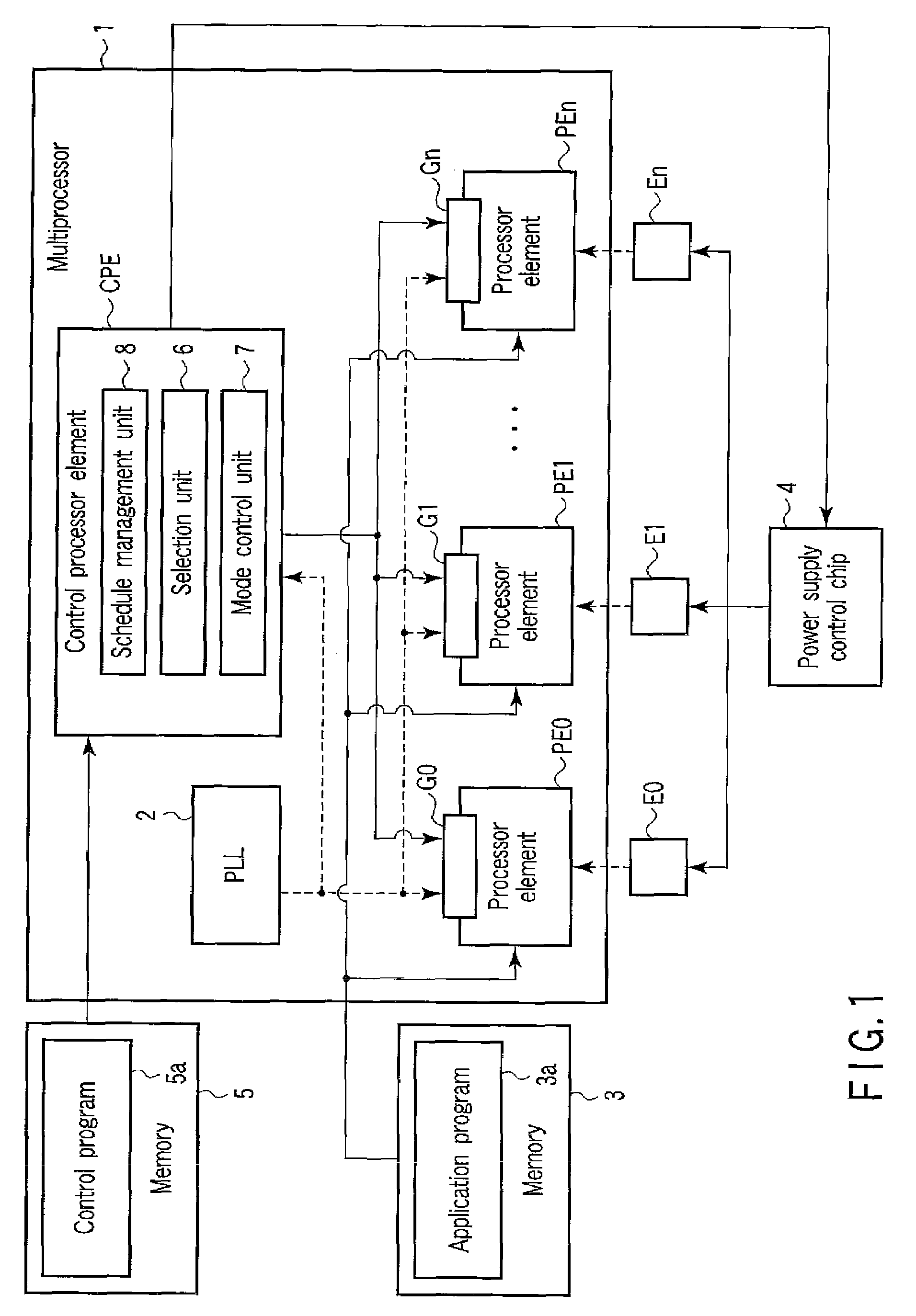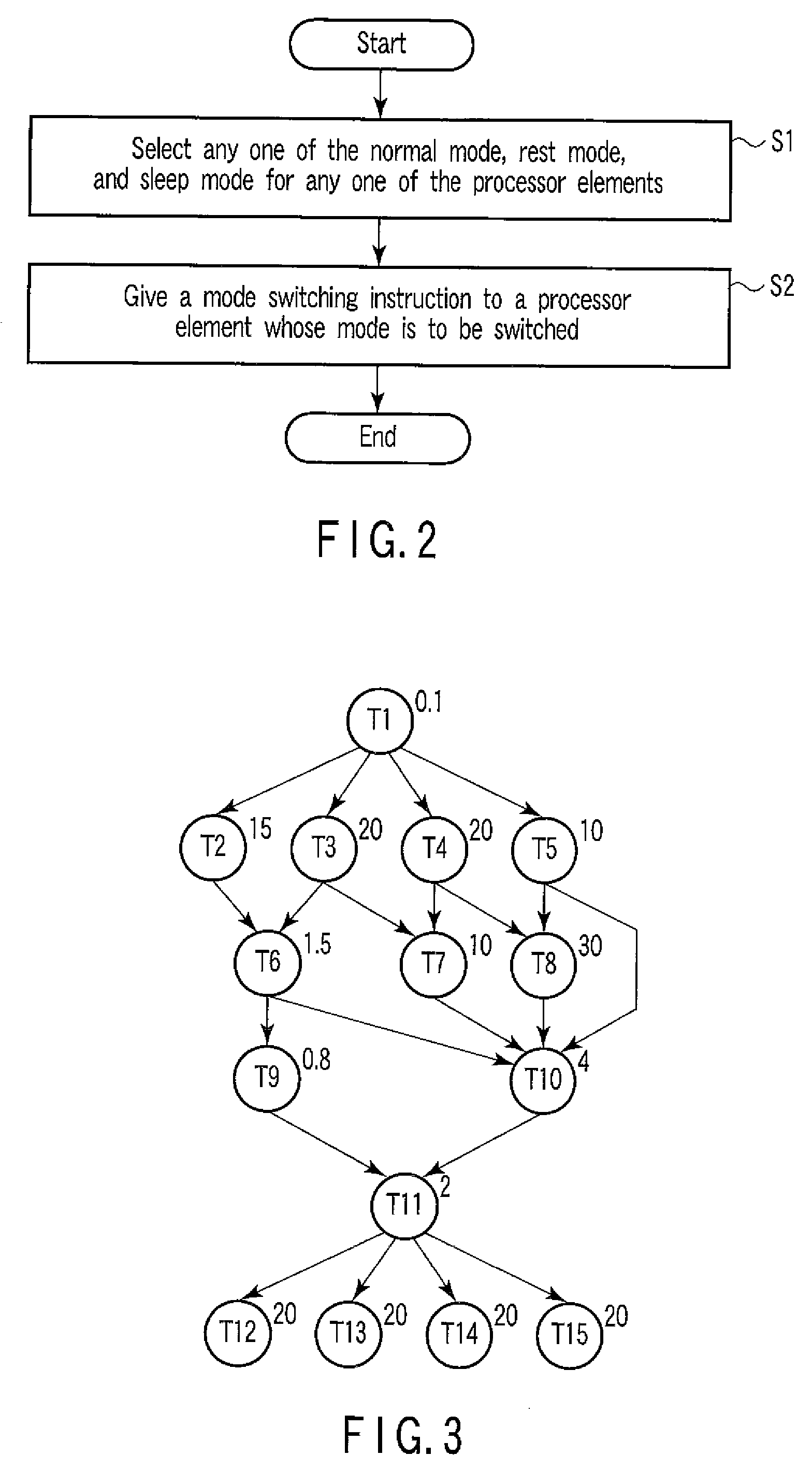Control Device and Method for Multiprocessor
- Summary
- Abstract
- Description
- Claims
- Application Information
AI Technical Summary
Benefits of technology
Problems solved by technology
Method used
Image
Examples
first embodiment
[0045]In a first embodiment of the invention, a control processor element (control unit) which schedules tasks and switches between a normal mode, a Rest mode, and a Sleep mode for each of processor elements in a multiprocessor that has a plurality of the processor elements mounted on a single chip will be explained.
[0046]In the first embodiment, an electric power consumption of the processor elements is suppressed in two stages: the Rest mode and Sleep mode.
[0047]FIG. 1 is a block diagram showing an example of a multiprocessor which includes a control processor element of the first embodiment.
[0048]A multiprocessor 1 has a plurality of processor elements PE0 to PEn on a single chip. The multiprocessor 1 further includes a PLL (Phase Locked Loop) 2 for generating a clock signal and a control processor element CPE.
[0049]The processor elements PE0 to PEn execute an application program 3a stored in a memory 3.
[0050]The processor elements PE0 to PEn are provided with clock gates G0 to G...
second embodiment
[0117]In a second embodiment of the invention, a modification of the first embodiment will be explained. In the second embodiment, an explanation will be given about a comparison between a case where optimization is performed to concentrate tasks which need not be executed in parallel into a specific processor element and a case where they are not concentrated.
[0118]In the second embodiment, it is assumed that, of 100% of the power consumed in the multiprocessor, 50% is consumed in AC, 40% is consumed in the clock, and 10% is consumed in DC. Here, AC means the power consumed in the operation of a circuit. The clock means the power consumed in the clock supplied to the block. DC means the leakage power of the circuit.
[0119]Moreover, in the second embodiment, suppose the Rest mode is a mode in which the operating frequency is suppressed to ¼ and the Sleep mode is a mode in which the supply of the clock is stopped (clock gating).
[0120]In this case, as illustrated in FIG. 8, in the Rest...
third embodiment
[0131]In a third embodiment of the invention, a control unit for a microprocessor obtained by modifying the first and second embodiments and further dividing the Rest mode into a plurality of modes will be explained.
[0132]FIG. 12 is a block diagram showing an example of a multiprocessor which includes a control processor element of a third embodiment.
[0133]A multiprocessor 11 includes a plurality of processor elements PE0 to PEn r a PLL (Phase Locked Loop) 12, and a control processor element CPE1.
[0134]The processor elements PE0 to PEn execute an application program 3a stored in a memory 3.
[0135]Power supply modules F0 to Fn supply power to the processor elements PE0 to PEn, respectively.
[0136]According to a power supply switching instruction given from the control processor element CPE1, a power supply control chip 13 switches between power supply and power stoppage by the power supply modules F0 to Fn. Moreover, the power supply control chip 13 varies the power supply voltage supp...
PUM
 Login to View More
Login to View More Abstract
Description
Claims
Application Information
 Login to View More
Login to View More - R&D
- Intellectual Property
- Life Sciences
- Materials
- Tech Scout
- Unparalleled Data Quality
- Higher Quality Content
- 60% Fewer Hallucinations
Browse by: Latest US Patents, China's latest patents, Technical Efficacy Thesaurus, Application Domain, Technology Topic, Popular Technical Reports.
© 2025 PatSnap. All rights reserved.Legal|Privacy policy|Modern Slavery Act Transparency Statement|Sitemap|About US| Contact US: help@patsnap.com



